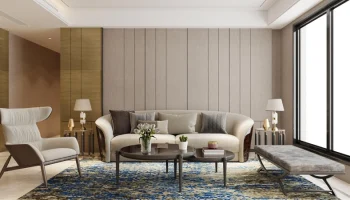Wall cladding is a process that is used to lay a material over another material to create a skin or layer on the wall. This decorative covering protects the underlying structure and makes your wall look aesthetically pleasing. In construction, wall cladding is used to improve weather resistance, thermal insulation, and the architectural style of the building. It can be used both on the exterior and interior. The only difference between the two is that exterior wall cladding is designed to withstand direct exposure to the sun, humidity, weather, and other temperature fluctuations, whereas interior wall cladding is designed to combat less.
Now that you know what wall cladding is and how it can be useful, let’s discuss some of its common types along with their pros and cons.
Top 5 Types Of Wall Cladding
- Stone Wall Cladding
Natural stone offers a feeling of warmth and it is one of the most eco-friendly materials used in interiors. The cost of stone wall cladding depends on the type of stone being used such as Sandstones, Limestones, Slates, Quartzites, and Granites. The cost also depends upon the size and shape of the stone required. Stone wall cladding can be installed over a surface made of steel and concrete.
- Wooden Wall Cladding
Among all types of cladding, wood is considered as one of the most aesthetically pleasing materials. Many homeowners opt for wooden wall cladding as it offers a warm, rustic, and attractive appeal to your interior. The material is an incredibly good insulator, easy to install, and durable.
- Brick Wall Cladding
Brick cladding works perfectly against protecting your walls from everything they may be exposed to. This type of cladding will not rot or crack with time. It keeps your indoor temperature maintained throughout the year. The natural thermal insulating features of brick wall cladding significantly reduce energy consumption rates.
- Stainless Steel Wall Cladding
Stainless steel wall cladding is extremely durable and can be used both on the interior and exterior of buildings. This type of cladding possesses high resistance to environmental fluctuations. Even though stainless steel functions like other cladding, it has the added benefit of being aesthetically pleasing. It can give your home a modern, sleek look. In addition to stainless steel, there are also other metal wall cladding types available such as copper and aluminum with the latter type being more common.
- Vinyl Wall Cladding
Vinyl wall cladding is one of the cheapest cladding types and it is available in an array of colors. It is durable, scratch resistant, and very effective in insulation. Vinyl cladding not only saves you money in installation but also in the long run, creating your indoor temperature comfortable throughout the year. Moreover, this type of cladding does not require re-painting.
So, we’ve discussed the top 5 types of wall cladding types with you. In addition, to protect your walls, this process can also add beauty to your space. So, if you want more creativity in your building or home, consider any of the above types!







